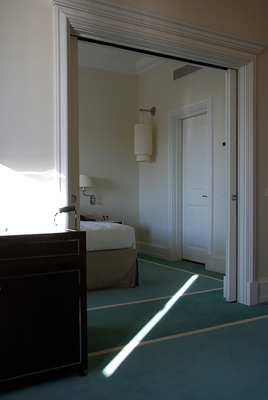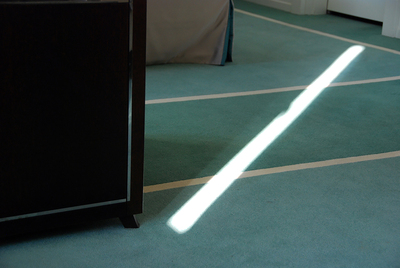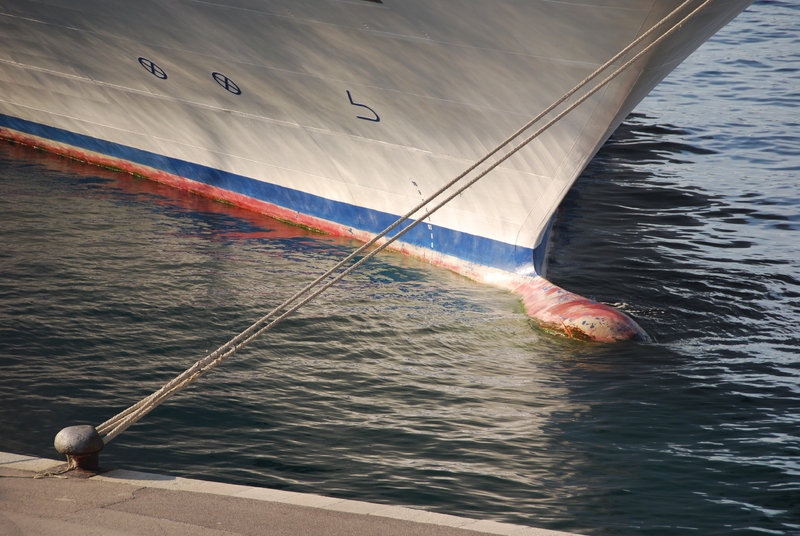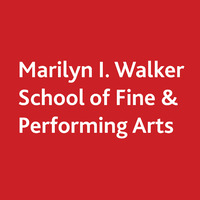Derek J.J. Knight: Art from a Hotel Bedroom
Trieste 1 & 2 : Light, Apparition and Duration
An empty hotel room save for the photographer
I visited Trieste in 2015. I was interested in the work of Carlo Scarpa, the Venetian born architect whose minimalist-inspired renovation of the Fondazione Querini Stampalia and interior garden I had visited in Venice. His genius was to design open sluices that ran around the ground-floor rooms and which filled with water when high tides flooded the building. In 1963 he had also been commissioned to rehabilitate the Revoltella Museum in Trieste, but owing to unforeseen circumstances, it was only completed in 1991 after his death. I stayed at the Savoia Excelsior Palace, a grand hotel built in 1911 and overlooking the port. The morning light reflecting off the Adriatic was blindingly bright and I was fascinated by the shaft of brilliant sunlight that penetrated the blinds covering French windows. The olive-green carpet with its white border was an apparition that bounded and contained the edge of the rooms as well as the larger furniture pieces such as the bed, putting me in mind of Lars von Trier and the Danish filmmaker’s minimalist chalk mark floor designs for his film Dogville (2003). The décor of the hotel room was more in keeping with the film sets of the 1950s and the colourized versions of black and white films by Alfred Hitchcock. Yet the shaft of light, edging dramatically across the room, was a demonstration of the sun’s powerful rotation and function as a timeless heliotrope.
In this time of a pandemic the northern Italian city of Trieste, where this photograph was made, is still empty of tourists. The Revoltella Museum with the addition designed by Carlo Scarpa, is a hybrid of visual art, artifacts and furnishings, empty of visitors at the time of writing, but pristine and punctuated by shafts of natural daylight that Scarpa conjured in an otherwise Baroque structure. Shafts of sunlight become neon vectors as you enter the nave of the Chiesa Rossa in Milan or the corridor lit by the artist Dan Flavin’s neon works at the Villa Panza in Varese. All of these are prompted by the shaft of light in a hotel room that disappears as quickly as it appeared, only to return tomorrow, and every other day ad infinitum. It is the angle of the hotel room to the horizon beyond the port and the early morning sun that allows me to think of this interior space as an observatory, much like the floor of San Petronio in Bologna with its north-south oriented meridian line etched into the tile surface. Its function since time immemorial has been to trace the sun’s movement.
Derek J.J. Knight, an Associate Professor, has been on faculty in the Department of Visual Arts at Brock University, St. Catharines, Ontario since 1985. Educated at Croydon College of Art, London, England, Carleton University, Ottawa, and State University of New York at Buffalo, he teaches courses in 20th century European and North American art history, contemporary art and theory, and contributes to the MA program in Studies in Comparative Literatures and Arts.
Knight has developed a profile as an independent curator and was awarded the INCO prize for curatorial writing in support of his exhibition “N.E. Thing Co.: The Ubiquitous Concept” at Oakville Galleries in 1995. He has written catalogue essays, authored scholarly papers, and lectured extensively on contemporary art. His studio activities comprise photography, installation and collaborative field research principally under the guise of ARTIndustria, a collaboration between himself and Franc Petric, and include participation in exhibitions at the London Regional Art Gallery (1988), Sarnia Public Library and Art Gallery (1988), Castellani Art Museum, Niagara University, New York (1988), Hallwalls, Buffalo (1989), Forest City Gallery, London (1989), Workscene Gallery, Toronto (1989, 1990, 1991), Eye Level Gallery, Halifax (1995), Contemporary Art Forum/CAFKA02, Kitchener (2002), Ice Follies, Lake Nipissing, North Bay (2008), Silo City, Buffalo (2017), and Rodman Hall Art Centre, St. Catharines (2020).
He was Director of the Marilyn I. Walker School of Fine and Performing Arts between 2009-16 and held Brock University’s first endowed Research Chair in Creativity, Imagination and Innovation.
Decipherment of Linear C
Tim Conley
Wherein lies the allure of the straight line?
Temerity. To dare the stroke, the gesture of direct connection. The power to negate or to extend. Always at the risk of missing, of turning, of halting too soon.
Recognition. On the one hand, the very essence of limitation: this way, just so, like that. On the other hand, acceptance of form as a means of discovering what is new: the pick-up line only succeeds when understood as a line.
Impossibility. There is no such thing as a straight line, but nonetheless. Every ray is Quixotic.
Exactitude. The embodiment of distinction. Literally, to send out, to drive forward. Determination transmitted.
Speed. Expressive synthesis of a magnitude and a direction. Light’s velocity is designated as c (Wallace Stevens’s “final Projection”), a curve, but we (with Emily Dickinson, she of the “certain slant of light”) think of the dash —
Termination. For all its continuity, those countless points in agreement on a shared trajectory, this solidarity of purpose also insists on an end. Thus far and no further.
Emphasis. Imagine the first act of underlining: was it for the benefit of another, or oneself? Was it a signal of deep accord or the beginning of an argument?
La sculpture
Catherine Parayre
Depuis des années, j’admire la maison de René Meinthe dans La villa triste de Patrick Modiano parce que, bien plus que construite, elle semble flotter dans l’air et les songes. Elle est couleur délavée par le souvenir et le temps ; elle dit la lumière et son vide.
Dans la chambre d’hôtel de Trieste, la lumière est également un vide, un geste sans destination, qui sait rester geste, qui ne cite rien si ce n’est sa modernité sculpturale tout autant qu’une postmodernité toute en références et allusions. Laisser le regard se blesser à ce rayon trop vif est comme se plonger dans une exposition d’art ; c’est inviter les savoirs que créent les artistes pour mesurer l’espace, le rêve et nos cultures. C’est imaginer l’acier et autres matériaux lourds, solides, qui fondent la pensée et tracent de longs voyages intellectuels pour comprendre les concepts dont nous nous entourons.
J’ai un ami à Trieste qui rénove une vieille maison, rose, en haut d’une colline. Il y est heureux ; Trieste est son point de chute – et un panorama sous ses yeux. Peu à peu, il s’y fait des connaissances et les invitent parfois à des cocktails dans le jardin de sa maison en travaux, sommairement meublée, fenêtres et portes grand ouvertes pour que s’échappent la poussière et les odeurs du chantier. Dans son jardin, on se tient debout et on parle calmement, mais avec plaisir. On invente d’autres mondes et on voit la pénombre du soir glisser le long des rues vers le haut des collines. C’est alors la lumière merveilleuse du crépuscule qui ouvre les abords d’une nouvelle nuit, ses douceurs et ses oublis, peut-être le sommeil, une lumière qui ne jaillit plus comme une lame qui découperait nos chambres et nous demanderait d’être alertes.
Il y a quelques années, j’ai passé les mois d’hiver dans un hôtel à Briançon, ville accrochée aux Alpes, la plus élevée – dit-elle – d’Europe. Proche du col de Montgenèvre, à la frontière italienne, elle est entourée de stations de ski et, à l’époque, de casernes militaires. L’hiver y est blanc de neige. Le bonheur de la vie d’hôtel, libre des corvées du quotidien ; le soir, rires avec les voisins, un mauvais pianiste au bar qui veut absolument nous connaitre mais n’y parvient pas, des nuits dansées en désordre avec les skieurs de passage, et nous qui faisons la grasse matinée chaque matin pendant qu’ils descendent les pentes et épuisent leurs vacances dans la précipitation. Vivre dans un hôtel est, aussi, une lumière, un souvenir de passage bienfaisant, hors de la pesanteur du monde, une parenthèse hors du travail – le temps sculpté sur un autre mode, lent, sans but, seulement la neige et quelques résidents à long terme.
C’est exactement ce que me montrent Trieste 1 et Trieste 2 : un bien commun, un espace partagé sans les contraintes du quotidien, l’absence bénéfique d’une histoire trop précise, une porte entrouverte sur l’extérieur qui ne trahit aucune intimité ou permanence, la grande beauté du rien et de ces lieux qui n’en sont pas – ou pas vraiment – pour mieux former la clarté des apaisements.
Outreach Activity: Your Turn to Create!
You may have noticed that the three texts commenting the photographs in Art from a Hotel Bedroom are about Trieste I and II only. Trieste III (showing a ship) is all yours! Feel free to write about it and send your text to us.
Vous avez peut-être remarqué que les trois textes commentant Art depuis une chambre d’hôtel portent uniquement sur Trieste I et II. Trieste III (qui montre un bateau) est pour vous ! Sentez-vous libres d’écrire à son sujet et de nous envoyer votre texte.
TO SHARE YOUR CONTRIBUTION WITH US, click on Outreach Activities on the main site of the Interiors platform and send us your file in Word (for text only) or JPEG (for images). (Please do not send videos or audio recordings.)
Provide your name and your email address. If you wish to use a fictive name, don’t forget to include it. Your email address will not be made public; we will use it only if we need to be in touch with you.
The curatorial team reserves the right to edit or not publish inadequate submissions.
POUR PARTAGER VOTRE CONTRIBUTION, cliquez sur Outreach Activities sur la page principale de la plateforme Interiors et envoyez-nous votre texte (sous Word) et/ou une image (au format JPEG). (Merci de ne pas envoyer de vidéos ou d’enregistrements audio.)
Donnez votre nom et votre adresse courriel. Si vous souhaitez utiliser un nom fictif, n’oubliez pas de l’inclure. Votre adresse courriel restera confidentielle et sera utilisée uniquement si nous devons nous mettre en contact avec vous.
L’équipe curatoriale se réserve le droit de modifier ou de ne pas publier toute soumission qui ne correspondrait pas au projet.



